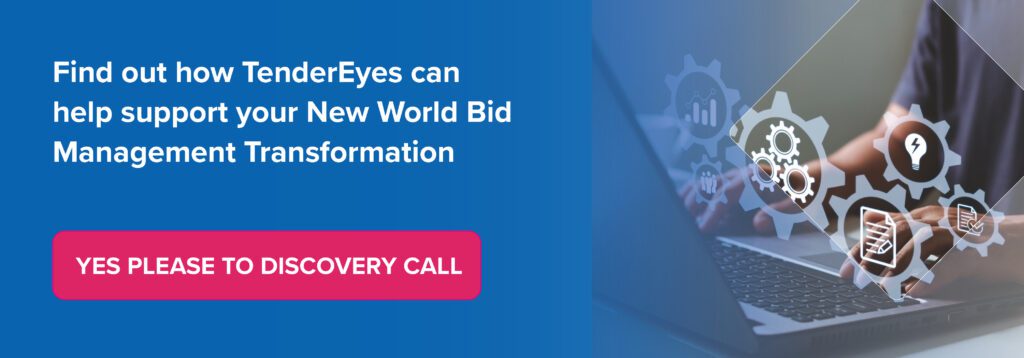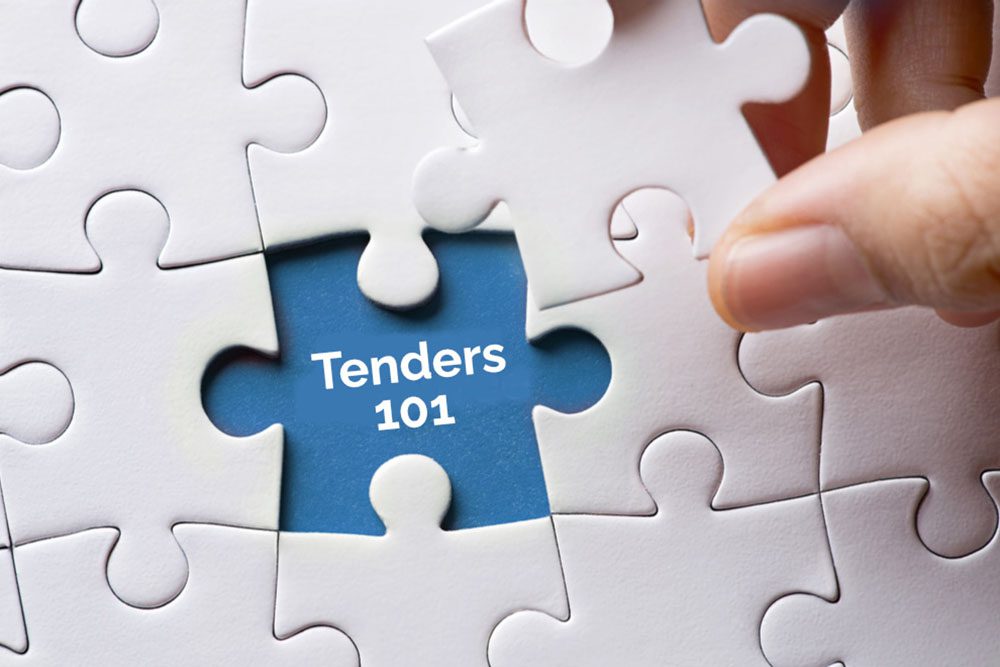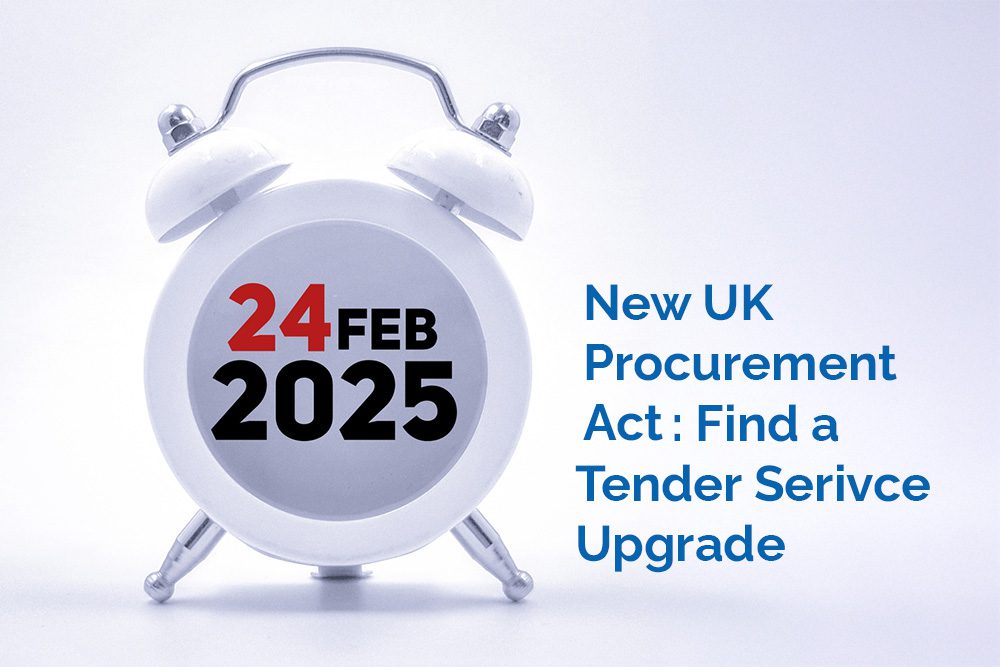Many organisations are increasingly looking to improve their global or regional strategic bid management. But strategic leaders are struggling to gain alignment and deeper understanding of their country and divisional activities and results.
Not surprising, given that commonly, these teams are working in isolation from each other, with differing processes, decision making, and support tools to deliver tender submissions.
Let’s review the top 10 challenges being experienced by strategic leaders — and how these can be resolved by working with TenderEyes.
What Are the Top Strategic Bid Challenges for Global/Regional Leaders?
As we discussed in our article “New World Bid Management – The Smarter Path to Tender Success” the old ways of working no longer work – in fact the significantly hinder bid success rates!
Strategic leaders are taking a wider holistic view of their bid management activities, and seeking to bring alignment at a regional and global level. But as we know from discussions with industry leaders and customers, they are running into the following problems.
- Navigating the Bidding Universe: Difficult to source & analyse data for market, competitor & industry insights.
- Unlocking Internal Bid Intelligence: Time consuming to aggregate and analyse data from individual countries.
- Driving Data-Driven Tender Decisions: Little insight to develop robust data-informed bidding strategies.
- Maximising Bidding Resources: Hard to schedule & plan resources with little visibility to country level activity.
- Eliminating Operational Inefficiency: Inconsistent processes, repetitive manual tasks and unwarranted time delays.
- Building Higher-Performing Bid Teams: Teams work in silos with limited communication, collaboration, or alignment.
- Managing Tender Risks, Governance & Security: Poor content management and inconsistent decision making & approvals.
- Elevating Bid Response Quality: Rushed & repeated re-use of low scoring responses with little time to review & improve.
- Securing Tender Reviews, Feedback & Learning: Lack of review, insights data and feedback opportunities.
- Creating Continuous Bid Improvement Culture: Hard to implement global or regional improvements and best practice.
So let’s explore these in detail and find out how TenderEyes can help solve these strategic bid management challenges.
1. Navigating the Bidding Universe
It is vital to have comprehensive knowledge and understanding of your industry, its activities and competitors. Without this intelligence, it is more problematic to develop robust strategies that address potential threats and optimise new opportunities.
However, gaining access to relevant data is challenging for suppliers bidding for public procurement contracts. While Contract Notices & Awards are easily available through Public Procurement Portals for bid action, collating such content in a suitable format for analysis requires investment in time, resources and expertise.
Challenges include:
- Fragmented Data Sources: Making it extremely difficult and time-consuming to compile and keep a comprehensive database updated.
- Inconsistent Data Quality: Leading to incomplete insight and inaccurate assessment of the bidding environment.
- Volume of Data: In Europe alone, 801,444 Contract Notices & Awards were published in 2024, requiring the right tools to analyse trends and opportunities.
- Geographical Factors: Different countries will have varying levels of transparency, access to public data, and regulations that affect tendering processes.
Strategic leaders, therefore, need a centralised and intelligent data solution to capture, structure and visualise their bidding universe. This enables clear understanding of market share, competitor pressures and potential market growth opportunities.
As explored in our “Deeper Insights for Better Bid Decisions” blog, organisations that master this intelligence gain competitive advantage, optimise targeting, and can forecast with greater confidence.
How TenderEyes Helps
TenderEyes Market Insights provides an ideal solution to address the above challenges. Giving you easy access to live and historic Contract Notices & Awards, with powerful analysis and easy to interpret dashboards and reporting.
This gives strategic leaders real-time visibility across their markets and categories, enabling data-informed strategic decisions on where to focus investment, resources and bidding activities.
2. Unlocking Internal Bid Intelligence
Understanding internal country and divisional bid activities, decision-making, performance and results is another critical area of intelligence required for strategic decision making.
However, as we know from our customers, this is an arduous task. Requesting, collating, formatting and analysing performance & results data from countries for regional or global insight is challenging, often taking days or even weeks!
Why?
Because individual countries or divisions work in isolation, with differing processes, tools and data capture. Many are still managing bids in spreadsheets, with variations in field headers, accuracy and consistency of input. Some may not capture key data points at all, such as qualification scores, win/loss reasons or value outcomes.
This lack of structured, reliable data means strategic teams are often making decisions blind, unable to identify trends, measure ROI, or benchmark performance.
How TenderEyes Helps
TenderEyes provides a single global system of record for all tendering activities. By standardising data captured across countries and divisions, it delivers unified dashboards and reports that allow instant visibility of performance, pipeline, and results. This provides strategic leaders with significant time savings whilst giving them the confidence in data accuracy and completeness.

3. Driving Data-Informed Tender Decisions
As with any strategic decision, relying on gut instinct and tacit knowledge alone is a dangerous game.
The lack of bidding universe and internal performance intelligence discussed above, makes it extremely difficult for strategic leaders, such as Market Access, Customer Experience and Business Development Managers, to develop high-level, robust bidding strategies.
Strategic leaders must be able to:
- Identify priority markets and product areas
- Recognise gaps in coverage or capabilities
- Monitor emerging threats such as new entrants or aggressive pricing
- Detect new opportunities, including changing buyer preferences, new product innovations or new markets.
Without these data-informed insights, it is also challenging to ensure countries and divisions stay on track and aligned to business goals and objectives. It is all too easy for teams to revert to a ‘bid for everything mentality’ rather than stay focused on best-fit opportunities. Imagine the impact if this happens across multiple countries!
Tender strategies also need to be dynamic and agile, evolving with market shifts and internal learning. Regular monitoring, planning, and proactive adjustments are essential to address potential threats and stay ahead of competitors in your chosen markets.
How TenderEyes Helps
TenderEyes provides strategic teams the insight they need to develop and refine evidence-based strategies. The combination of external market and internal data provides a powerful tool in strategy development. It supports segmentation, targeting, and prioritisation, enabling corporate wide investment and focused pursuit of high-value, best-fit contracts.
4. Maximising Bidding Resources
Bidding is a resource-intensive activity requiring substantial investment in people, money and time. From qualification and content creation to review and approval, each tender involves multiple disciplines and levels of expertise.
At a global or regional level, limited visibility into local workloads, capacity and timelines makes resource planning extremely difficult. Strategic leaders can often struggle to identify overburdened teams or underutilised expertise. This can lead to burnout in some regions and missed opportunities in others.
Without a structured overview, it’s also hard to schedule and plan complex multi-country bids, coordinate shared resources, or ensure deadlines are met.
“The lack of an effective workforce planning strategy can lead to a loss of 20-30% of productivity.” McKinsey
How TenderEyes Helps
TenderEyes provides real-time visibility of all ongoing, completed and planned tenders, allowing strategic leaders to track workloads, assign tasks, and balance resources efficiently.
Through centralised calendars, role-based assignments and workflow automation, teams can plan proactively, prevent roadblocks and optimise performance. This saves valuable time which can be better spent focused on improving tender submission quality and win rates.
5. Eliminating Operating Inefficiency in Tendering
At every stage of the bid journey, from qualification to submission, there are countless repetitive and manual tasks undertaken by multiple teams across multiple countries and divisions. Without standardised processes, automation or collaborative tools, these tasks become major sources of inefficiency leading to frustration, reduced engagement and mistakes.
Common pain points include:
- Duplicating and inputting data within multiple systems and spreadsheets
- Duplicating work for similar bids
- Chasing colleagues for content, updates or approvals
- Searching for previous responses or documents
- Reusing previous low-scoring tender responses
- Lengthy ‘cut and paste’ actions to compile draft submissions.
Impacts include wasted time, reduced productivity, and increased risk of missing deadlines, or submitting incomplete or low-quality tenders.
In our Blog ‘Top 7 Repetitive Activities to Avoid in Tender Management’ we further explore these challenges and the impact they have on bid submissions.
How TenderEyes Helps
TenderEyes streamlines and automates repetitive tasks through intelligent workflows, templates, and a centralised content library. Teams can quickly locate, reuse, and tailor responses, while automated reminders keep everyone on track. This boosts team morale, commitment and efforts to submit better quality tenders.

6. Building Higher-Performing Bid Teams
Strategic tendering success depends on cross-functional collaboration. This may involve sales, market access, marketing, bid, pricing, legal and compliance teams, who may be in different divisions, countries and time-zones. Thus, operating in silos and using disconnected tools and communication channels.
Bidding responsibilities may also cause conflict with team and individual job responsibilities and given reduced priority over normal work commitments and pressures.
These challenges lead to activity and communication misalignment, duplication of effort, unnecessary delays and inconsistent outputs. Without a shared workspace or clear visibility of progress, accountability and engagement can suffer.
Our blog “Tender Success! Essential Collaboration Tactics!” highlights how connected teams can improve collaboration and deliver higher quality tender responses.
How TenderEyes Helps
TenderEyes allows strategic leaders to better foster team working and commitment by bringing all business stakeholders together within a single collaborative platform. Team members have clear visibility to projects, stages, roles and tasks with deadlines, automated notifications and reminders to keep them on track.
Strategic leaders also have full visibility to project progress and results, to identify collaboration roadblocks and delays, helping them formulate future improvement plans.

7. Managing Tender Risk, Governance & Security
Inconsistent processes, informal decision-making, and poor content management can expose organisations to significant IP, brand and financial risks when bidding for tenders.
Without clear governance frameworks, organisations may struggle to stay compliant, manage version control, or ensure proper approvals, particularly important in regulated industries such as MedTech and Insurance.
Furthermore, storing sensitive tender data in unsecured spreadsheets or shared drives increases risk of data breaches and non-compliance with data protection regulations.
Without clear visibility to bid management practises, risk management leaders will struggle to identify areas of risk and improvement.
“57% of risk leaders are on track to spend more for the automation of their processes so that they can better monitor risks.” PwC Pulse Survey
How TenderEyes Helps
TenderEyes ensures robust company-wide governance and security through structured approval workflows and decision gates, audit trails, and secure, permission-based access. Leaders can enforce global standards while allowing local flexibility.
Sensitive information, documentation and Tender Q & As can be better managed via the TenderEyes Knowledge Bank. This provides content ownership, validity dates, version control, approvals and update reminders, ensuring submission content is accurate, up to date and on brand.
Global teams can also easily disseminate information, such as marketing collateral, product information and pricing models, to their divisions, regions and countries through TenderEyes. This means teams can stay agile and ensure inclusion of the right information within their bid submissions.
8. Elevating Bid Response Quality
Ensuring your teams are focused on high quality best-fit tenders is vital for long term growth and success. However, consistently achieving this across all teams at a global, divisional or regional level can be extremely difficult.
This starts with the development and implementation of robust targeting strategies and pursuit decisions to ensure only tenders with high win probabilities are pursued. Time spent on mismatched opportunities can put teams under undue pressure and lead to wasted time and resources.
Tender submission quality is also dependent on the time taken to finesses responses – to ensure they are compliant, competitive, compelling and convincing. However, due to deadline constraints, teams may resort to reusing old content, without reviewing or improving them. This can lead to low-scoring responses being repeatedly used across bids, limiting innovation and competitive differentiation. Thus, resulting in decreased win rates and market share, over time.
How TenderEyes Helps
TenderEyes Opportunity Manager ensure your sales teams are aligned across your whole business in the pursuit of best-fit tenders. This is achieved using customisable filtering (keywords & procurement codes), consistent qualification criteria and approval workflows.
While, TenderEyes Knowledge Bank provides your teams with a centralised, searchable library of content. Approved and regularly updated responses can be reused with confidence, while built-in review workflows ensure continuous improvement.
As discussed in our blog “Building a Winning Tender Content Library”, maintaining a well-curated repository is essential for efficiency, compliance and competitive edge.
9. Securing Tender Reviews, Feedback & Learning
Capturing feedback post-tender is critical for review and learning. But is often an afterthought and may be forgotten entirely, when teams are focused on delivering the next bid submission.
The lack of processes or tools to track win/loss reasons, evaluation scores or pricing differentials makes this even more challenging. Even where feedback exists, it is often stored locally and very difficult to consolidate at regional or global level.
Unfortunately, this results in strategic teams being unable to gain valuable insights on performance and results. Without systematic feedback collection and performance reporting, it’s impossible to learn from mistakes or replicate success.
How TenderEyes Helps
Bid performance reviews can be built into TenderEyes as project stages and ensures the structured capture and analysis of post-bid feedback for all tender submissions.
Centralised dashboards and reporting can provide strategic leaders with live insights to better understand their win/loss patterns, response effectiveness, and improvement priorities. Empowering them to make better informed decisions.
10. Creating Continuous Bid Improvement Culture
With such complexity involved in the bid process, it is vital for businesses to secure on-going improvements to sustain long-term success. This requires clear visibility of performance, process efficiency and content quality, to achieve at a global or regional scale.
At the local level teams may recognise recurring issues, such as missed deadlines, poor qualification, or inconsistent scoring, but lack the means to track, measure and implement improvements. Strategic decision makers need to lead and invest in implementing improvements that result in measurable benefits and improved results.
How TenderEyes Helps
TenderEyes provides the analytics, insights and structured workflows to embed continuous improvement into daily tender management. From automated KPI tracking to performance benchmarking, leaders can identify trends, implement corrective actions, and measure impact.
As outlined in “Gaining Competitive Advantage in Public Tendering”, maturity in tendering isn’t achieved once — it’s built through ongoing improvement across every aspect of your bid journey and activities. All with the aim to win bigger and better!







